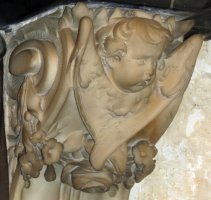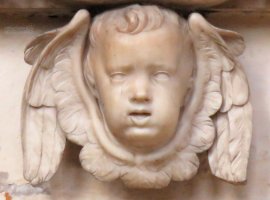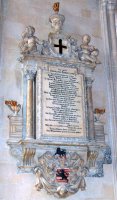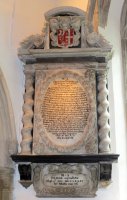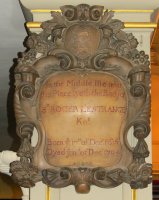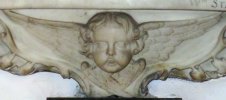William Stanton (1639-1705)
The sculptor William Stanton, most significant of a dynasty of English sculptors, has a variety of monuments from the later 17th Century in churches across England. While he made a number of figure pieces, notably for Stonyhurst, his most characteristic works are large panel monuments, usually with pillars and decorated with various sculptural embellishments.
William Stanton worked as a sculptor from the 1660s, including on architectural decorations, and monuments, making his first piece for Westminster Abbey as early as 1670. His base was at St Andrew’s Holborn, London, and by the end of the 1670s he employed nine men in what was for a time perhaps the largest mason’s workshop in London. He achieved distinction in the professional body, the Mason’s Company, eventually becoming Master in 1688-89, though declining to hold the role for longer, and was the mason for Gray’s Inn. He also seems to have spent periods elsewhere in the country, working to one or another great lord, including particularly as master mason for Belton House in Grantham, and later at Stonyhurst. He was working on a monument to the fourth Earl of Leicester at the time of his death in 1705.
Some 90-odd church monuments by Stanton are listed by Gunnis, the sculptural historian, and there are various other works which have been ascribed to him or his workshop with varying degrees of likelihood. Grand figure pieces by Stanton include the series of full length effigies of members of the Shireburn family for Stonyhurst, and reclining figures of the 3rd Earl Rivers in Macclesfield, the 1st Earl of Coventry in Elmley Castle, and an armoured Hugh Smithson in Stanwick, Yorks, among others.
Typical wall panels by William Stanton.
Most characteristic of his work though are large, ornate wall panels in what became one of the predominant styles of his time, and through into the earlier 18th Century: Classical baroque pieces with thick pillars to the sides, and curved or broken, curly (swan necked) pediments above, and a variety of sculptural adornments including decorated pots, festoons of flowers, scrolls, and often cherubs or winged cherub heads (of which he made something of a speciality; see pictures at top of page - you will need to click to enlarge). Stanton worked almost entirely in monochrome: predominantly white marble, sometimes strongly streaked (another 18th Century favourite), and the occasional black elements for variety and added impact.
Cartouche panel by Stanton.
I must mention one outdoor work by Stanton, which is the great standing obelisk on a tomb chest to Edmund Waller, d.1687, in Beaconsfield - see near end of this page.
Stanton was buried near home at St Andrew’s Church, Holborn, where he had done work for Christopher Wren and carved the font, however nothing of his there, nor the family grave, survived the heavy World War II bombing of the locality.
Although William Stanton was the most important sculptor of the family, an uncle, Thomas Stanton (1610-1674) was fairly distinguished and has a few surviving monuments, including one in Worcester Cathedral, and one of his sons, Edward Stanton (1681-1734) became a prolific monumental sculptor in the first two decades of the 18th Century, and several other family members seem to have had at least a minor engagement in sculpture. Among William Stanton’s various apprentices, Robert Hartshorn was one who achieved a certain distinction in his own right.
